General Information About Adult Hodgkin Lymphoma
Adult Hodgkin lymphoma is a disease in which malignant (cancer) cells form in the lymph system.
Adult Hodgkin lymphoma is a type of cancer that develops in the lymph system, part of the body's immune system. The immune system protects the body from foreign substances, infection, and diseases. The lymph system is made up of the following:
- Lymph: Colorless, watery fluid that carries white blood cells called lymphocytes through the lymph system. Lymphocytes protect the body against infections and the growth of tumors.
- Lymph vessels: A network of thin tubes that collect lymph from different parts of the body and return it to the bloodstream.
- Lymph nodes: Small, bean-shaped structures that filter lymph and store white blood cells that help fight infection and disease. Lymph nodes are located along the network of lymph vessels found throughout the body. Clusters of lymph nodes are found in the neck, underarm, abdomen, pelvis, and groin.
- Spleen: An organ that makes lymphocytes, filters the blood, stores blood cells, and destroys old blood cells. It is located on the left side of the abdomen near the stomach.
- Thymus: An organ in which lymphocytes grow and multiply. The thymus is in the chest behind the breastbone.
- Tonsils: Two small masses of lymph tissue at the back of the throat. The tonsils make lymphocytes.
- Bone marrow: The soft, spongy tissue in the center of large bones. Bone marrow makes white blood cells, red blood cells, and platelets.

Anatomy of the lymph system, showing the lymph vessels and lymph organs including lymph nodes, tonsils, thymus, spleen, and bone marrow. Lymph (clear fluid) and lymphocytes travel through the lymph vessels and into the lymph nodes where the lymphocytes destroy harmful substances. The lymph enters the blood through a large vein near the heart.
Lymph tissue is also found in other parts of the body such as the stomach, thyroid gland, brain, and skin. Cancer can spread to the liver and lungs.
Lymphomas are divided into two general types: Hodgkin lymphoma and non-Hodgkin lymphoma. This summary is about the treatment of adult Hodgkin lymphoma. (See the PDQ summary on Adult Non-Hodgkin Lymphoma Treatment for more information.)
Hodgkin lymphoma can occur in both adults and children. Treatment for adults is different than treatment for children. Hodgkin lymphoma may also occur in patients who have acquired immunodeficiency syndrome (AIDS); these patients require special treatment.
See the following PDQ summaries for more information:
- Childhood Hodgkin Lymphoma Treatment
- AIDS-Related Lymphoma Treatment
Hodgkin lymphoma in pregnant women is the same as the disease in nonpregnant women of childbearing age. However, treatment is different for pregnant women. This summary includes information about treating Hodgkin lymphoma during pregnancy.
There are two main types of Hodgkin lymphoma: classical and nodular lymphocyte-predominant.
Most Hodgkin lymphomas are the classical type. The classical type is broken down into the following four subtypes:
- Nodular sclerosing Hodgkin lymphoma.
- Mixed cellularity Hodgkin lymphoma.
- Lymphocyte depletion Hodgkin lymphoma.
- Lymphocyte-rich classical Hodgkin lymphoma.
Age, gender, and Epstein-Barr infection can affect the risk of adult Hodgkin lymphoma.
Anything that increases your risk of getting a disease is called a risk factor. Having a risk factor does not mean that you will get cancer; not having risk factors doesn't mean that you will not get cancer. Talk with your doctor if you think you may be at risk. Risk factors for adult Hodgkin lymphoma include the following:
- Being in young or late adulthood.
- Being male.
- Being infected with the Epstein-Barr virus.
- Having a first-degree relative (parent, brother, or sister) with Hodgkin lymphoma.
Pregnancy is not a risk factor for Hodgkin lymphoma.
Signs of adult Hodgkin lymphoma include swollen lymph nodes, fever, night sweats, and weight loss.
These and other signs and symptoms may be caused by adult Hodgkin lymphoma or by other conditions. Check with your doctor if any of the following do not go away:
- Painless, swollen lymph nodes in the neck, underarm, or groin.
- Fever for no known reason.
- Drenching night sweats.
- Weight loss for no known reason.
- Itchy skin.
- Feeling very tired.
Tests that examine the lymph nodes are used to detect (find) and diagnose adult Hodgkin lymphoma.
The following tests and procedures may be used:
- Physical exam and history: An exam of the body to check general signs of health, including checking for signs of disease, such as lumps or anything else that seems unusual. A history of the patient's past illnesses and treatments will also be taken.
- Complete blood count (CBC): A procedure in which a sample of blood is drawn and checked for the following:
- The number of red blood cells, white blood cells, and platelets.
- The amount of hemoglobin (the protein that carries oxygen) in the red blood cells.
- The portion of the sample made up of red blood cells.
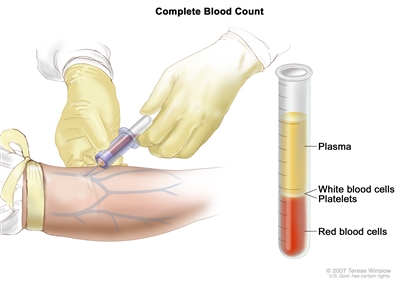
Complete blood count (CBC). Blood is collected by inserting a needle into a vein and allowing the blood to flow into a tube. The blood sample is sent to the laboratory and the red blood cells, white blood cells, and platelets are counted. The CBC is used to test for, diagnose, and monitor many different conditions. - Blood chemistry studies: A procedure in which a blood sample is checked to measure the amounts of certain substances released into the blood by organs and tissues in the body. An unusual (higher or lower than normal) amount of a substance can be a sign of disease.
- Sedimentation rate: A procedure in which a sample of blood is drawn and checked for the rate at which the red blood cells settle to the bottom of the test tube. The sedimentation rate is a measure of how much inflammation is in the body. A higher than normal sedimentation rate may be a sign of lymphoma or another condition. Also called erythrocyte sedimentation rate, sed rate, or ESR.
- Lymph node biopsy: The removal of all or part of a lymph node. One of the following types of biopsies may be done:
- Excisional biopsy: The removal of an entire lymph node.
- Incisional biopsy: The removal of part of a lymph node.
- Core biopsy: The removal of part of a lymph node using a wide needle.
A pathologist views the tissue under a microscope to look for cancer cells, especially Reed-Sternberg cells. Reed-Sternberg cells are common in classical Hodgkin lymphoma.
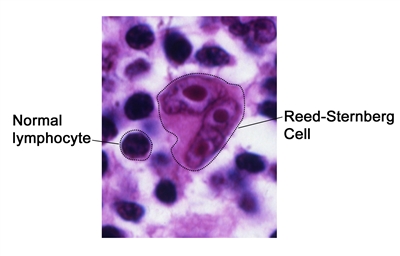
Reed-Sternberg cell. Reed-Sternberg cells are large, abnormal lymphocytes that may contain more than one nucleus. These cells are found in Hodgkin lymphoma.
The following test may be done on tissue that was removed:
- Immunophenotyping: A laboratory test used to identify cells, based on the types of antigens or markers on the surface of the cell. This test is used to diagnose the specific type of lymphoma by comparing the cancer cells to normal cells of the immune system.
Certain factors affect prognosis (chance of recovery) and treatment options.
The prognosis (chance of recovery) and treatment options depend on the following:
- The patient's signs and symptoms.
- The stage of the cancer.
- The type of Hodgkin lymphoma.
- Blood test results.
- The patient's age, gender, and general health.
- Whether the cancer is recurrent or progressive.
For Hodgkin lymphoma during pregnancy, treatment options also depend on:
- The wishes of the patient.
- The age of the fetus.
Adult Hodgkin lymphoma can usually be cured if found and treated early.
Stages of Adult Hodgkin Lymphoma
After adult Hodgkin lymphoma has been diagnosed, tests are done to find out if cancer cells have spread within the lymph system or to other parts of the body.
The process used to find out if cancer has spread within the lymph system or to other parts of the body is called staging. The information gathered from the staging process determines the stage of the disease. It is important to know the stage in order to plan treatment. The following tests and procedures may be used in the staging process:
- CT scan (CAT scan): A procedure that makes a series of detailed pictures of areas inside the body, taken from different angles. The pictures are made by a computer linked to an x-ray machine. A dye may be injected into a vein or swallowed to help the organs or tissues show up more clearly. This procedure is also called computed tomography, computerized tomography, or computerized axial tomography. For adult Hodgkin lymphoma, CT scans of the neck, chest, abdomen, and pelvis are taken.
- PET-CT scan: A procedure that combines the pictures from a positron emission tomography (PET) scan and a computed tomography (CT) scan. The PET and CT scans are done at the same time on the same machine. The pictures from both scans are combined to make a more detailed picture than either test would make by itself. A PET scan is a procedure to find malignant tumor cells in the body. A small amount of radioactive glucose (sugar) is injected into a vein. The PET scanner rotates around the body and makes a picture of where glucose is being used in the body. Malignant tumor cells show up brighter in the picture because they are more active and take up more glucose than normal cells do.
- Bone marrow aspiration and biopsy: The removal of bone marrow, blood, and a small piece of bone by inserting a hollow needle into the hipbone or breastbone. A pathologist views the bone marrow, blood, and bone under a microscope to look for signs of cancer.

Bone marrow aspiration and biopsy. After a small area of skin is numbed, a bone marrow needle is inserted into the patient's hip bone. Samples of blood, bone, and bone marrow are removed for examination under a microscope.
For pregnant women with Hodgkin lymphoma, staging tests that protect the fetus from the harms of radiation are used. These include:
- MRI (magnetic resonance imaging): A procedure that uses a magnet, radio waves, and a computer to make a series of detailed pictures of areas inside the body. This procedure is also called nuclear magnetic resonance imaging (NMRI).
- Ultrasound exam: A procedure in which high-energy sound waves (ultrasound) are bounced off internal tissues or organs and make echoes. The echoes form a picture of body tissues called a sonogram.
There are three ways that cancer spreads in the body.
Cancer can spread through tissue, the lymph system, and the blood:
- Tissue. The cancer spreads from where it began by growing into nearby areas.
- Lymph system. The cancer spreads from where it began by getting into the lymph system. The cancer travels through the lymph vessels to other parts of the body.
- Blood. The cancer spreads from where it began by getting into the blood. The cancer travels through the blood vessels to other parts of the body.
Stages of adult Hodgkin lymphoma may include A, B, E, and S.
Adult Hodgkin lymphoma may be described as follows:
- A: The patient does not have B symptoms (fever, weight loss, or night sweats).
- B: The patient has B symptoms.
- E: Cancer is found in an organ or tissue that is not part of the lymph system but which may be next to an involved area of the lymph system.
- S: Cancer is found in the spleen.
The following stages are used for adult Hodgkin lymphoma:
Stage I
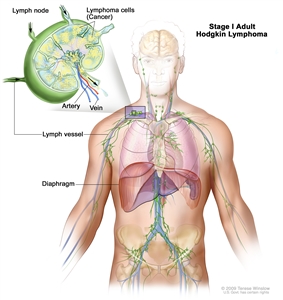
Stage I adult Hodgkin lymphoma. Cancer is found in one or more lymph nodes in one lymph node group. In stage IE (not shown), cancer is found outside the lymph nodes in one organ or area.
Stage I is divided into stage I and stage IE.
- Stage I: Cancer is found in one of the following places in the lymph system:
- One or more lymph nodes in one lymph node group.
- Waldeyer's ring.
- Thymus.
- Spleen.
- Stage IE: Cancer is found outside the lymph system in one organ or area.
Stage II
Stage II is divided into stage II and stage IIE.
- Stage II: Cancer is found in two or more lymph node groups either above or below the diaphragm (the thin muscle below the lungs that helps breathing and separates the chest from the abdomen).
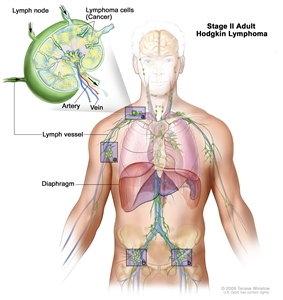
Stage II adult Hodgkin lymphoma. Cancer is found in two or more lymph node groups, and both are either above (a) or below (b) the diaphragm. - Stage IIE: Cancer is found in one or more lymph node groups either above or below the diaphragm and outside the lymph nodes in a nearby organ or area.
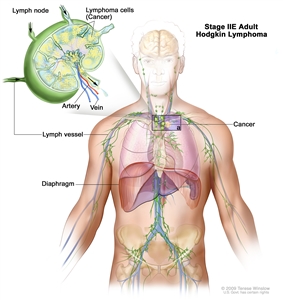
Stage IIE adult Hodgkin lymphoma. Cancer is found in one or more lymph node groups above or below the diaphragm and outside the lymph nodes in a nearby organ or area (a).
Stage III
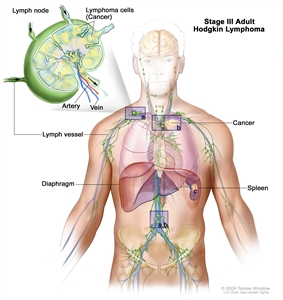
Stage III adult Hodgkin lymphoma. Cancer is found in one or more lymph node groups above and below the diaphragm (a). In stage IIIE, cancer is found in lymph node groups above and below the diaphragm and outside the lymph nodes in a nearby organ or area (b). In stage IIIS, cancer is found in lymph node groups above and below the diaphragm (a) and in the spleen (c). In stage IIIS plus E, cancer is found in lymph node groups above and below the diaphragm, outside the lymph nodes in a nearby organ or area (b), and in the spleen (c).
Stage III is divided into stage III, stage IIIE, stage IIIS, and stage IIIE,S.
- Stage III: Cancer is found in lymph node groups above and below the diaphragm (the thin muscle below the lungs that helps breathing and separates the chest from the abdomen).
- Stage IIIE: Cancer is found in lymph node groups above and below the diaphragm and outside the lymph nodes in a nearby organ or area.
- Stage IIIS: Cancer is found in lymph node groups above and below the diaphragm, and in the spleen.
- Stage IIIE,S: Cancer is found in lymph node groups above and below the diaphragm, outside the lymph nodes in a nearby organ or area, and in the spleen.
Stage IV
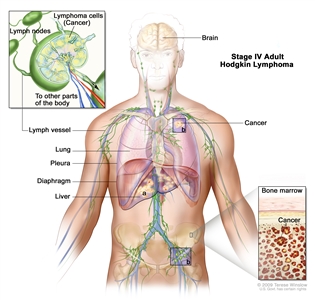
Stage IV adult Hodgkin lymphoma. Cancer is found outside the lymph nodes throughout one or more organs (a); or outside the lymph nodes in one organ and has spread to lymph nodes far away from that organ (b); or in the lung, liver, or bone marrow.
In stage IV, the cancer:
- is found outside the lymph nodes throughout one or more organs, and may be in lymph nodes near those organs; or
- is found outside the lymph nodes in one organ and has spread to areas far away from that organ; or
- is found in the lung, liver, bone marrow, or cerebrospinal fluid (CSF). The cancer has not spread to the lung, liver, bone marrow, or CSF from nearby areas.
Adult Hodgkin lymphoma may be grouped for treatment as follows:
Early Favorable
Early favorable adult Hodgkin lymphoma is stage I or stage II, without risk factors.
Early Unfavorable
Early unfavorable adult Hodgkin lymphoma is stage I or stage II with one or more of the following risk factors:
- A tumor in the chest that is larger than 1/3 of the width of the chest or at least 10 centimeters.
- Cancer in an organ other than the lymph nodes.
- A high sedimentation rate (in a sample of blood, the red blood cells settle to the bottom of the test tube more quickly than normal).
- Three or more lymph nodes with cancer.
- Symptoms such as fever, weight loss, or night sweats.
Advanced
Advanced Hodgkin lymphoma includes some or all of the following risk factors:
- Being male.
- Being aged 45 years or older.
- Having stage IV disease.
- Having a low blood albumin (protein) level (below 4).
- Having a low hemoglobin level (below 10.5).
- Having a high white blood cell count (15,000 or higher).
- Having a low lymphocyte count (below 600 or less than 8% of the white blood cell count).
Recurrent Adult Hodgkin Lymphoma
Recurrent adult Hodgkin lymphoma is cancer that has recurred (come back) after it has been treated. The cancer may come back in the lymph system or in other parts of the body.
Treatment Option Overview
There are different types of treatment for patients with adult Hodgkin lymphoma.
Different types of treatment are available for patients with adult Hodgkin lymphoma. Some treatments are standard (the currently used treatment), and some are being tested in clinical trials. A treatment clinical trial is a research study meant to help improve current treatments or obtain information on new treatments for patients with cancer. When clinical trials show that a new treatment is better than the standard treatment, the new treatment may become the standard treatment. Patients may want to think about taking part in a clinical trial. Some clinical trials are open only to patients who have not started treatment.
For pregnant women with Hodgkin lymphoma, treatment is carefully chosen to protect the fetus. Treatment decisions are based on the mother's wishes, the stage of the Hodgkin lymphoma, and the age of the fetus. The treatment plan may change as the signs and symptoms, cancer, and pregnancy change. Choosing the most appropriate cancer treatment is a decision that ideally involves the patient, family, and health care team.
Patients with Hodgkin lymphoma should have their treatment planned by a team of health care providers with expertise in treating lymphomas.
Treatment will be overseen by a medical oncologist, a doctor who specializes in treating cancer. The medical oncologist may refer you to other health care providers who have experience and expertise in treating adult Hodgkin lymphoma and who specialize in certain areas of medicine. These may include the following specialists:
- Neurosurgeon.
- Neurologist.
- Rehabilitation specialist.
- Radiation oncologist.
- Endocrinologist.
- Hematologist.
- Other oncology specialists.
Patients may develop late effects that appear months or years after their treatment for Hodgkin lymphoma.
Treatment with chemotherapy and/or radiation therapy for Hodgkin lymphoma may increase the risk of second cancers and other health problems for many months or years after treatment. These late effects depend on the type of treatment and the patient's age when treated, and may include:
- Acute myelogenous leukemia.
- Cancer of the breast, bone, cervix, gastrointestinal tract, head and neck, lung, soft tissue, and thyroid.
- Heart, lung, and thyroid disease.
- Avascular necrosis of bone (death of bone cells caused by lack of blood flow).
- Herpes zoster (shingles) or severe infection.
- Depression and fatigue.
- Infertility.
- Hypogonadism (low levels of testosterone and estrogen).
Regular follow-up by doctors who are expert in finding and treating late effects is important for the long-term health of patients treated for Hodgkin lymphoma.
Three types of standard treatment are used:
Chemotherapy
Chemotherapy is a cancer treatment that uses drugs to stop the growth of cancer cells, either by killing the cells or by stopping them from dividing. When chemotherapy is taken by mouth or injected into a vein or muscle, the drugs enter the bloodstream and can reach cancer cells throughout the body (systemic chemotherapy). When chemotherapy is placed directly into the cerebrospinal fluid, an organ, or a body cavity such as the abdomen, the drugs mainly affect cancer cells in those areas (regional chemotherapy). The way the chemotherapy is given depends on the type and stage of the cancer being treated. Combination chemotherapy is treatment with more than one anticancer drug.
When a pregnant woman is treated with chemotherapy for Hodgkin lymphoma, it isn't possible to protect the fetus from being exposed to the chemotherapy. Some chemotherapy regimens may cause birth defects if given in the first trimester. Vinblastine is an anticancer drug that has not been linked with birth defects when given in the second half of pregnancy.
See Drugs Approved for Hodgkin Lymphoma for more information.
Radiation therapy
Radiation therapy is a cancer treatment that uses high-energy x-rays or other types of radiation to kill cancer cells or keep them from growing. There are two types of radiation therapy:
- External radiation therapy uses a machine outside the body to send radiation toward the cancer.
- Internal radiation therapy uses a radioactive substance sealed in needles, seeds, wires, or catheters that are placed directly into or near the cancer.
The way the radiation therapy is given depends on the type and stage of the cancer being treated. External radiation therapy is used to treat adult Hodgkin lymphoma.
For a pregnant woman with Hodgkin lymphoma, radiation therapy should be postponed until after delivery, if possible, to avoid any risk to the fetus. If immediate treatment is needed, the woman may decide to continue the pregnancy and receive radiation therapy. However, lead used to shield the fetus may not protect it from scattered radiation that could possibly cause cancer in the future.
Surgery
Laparotomy is a procedure in which an incision (cut) is made in the wall of the abdomen to check the inside of the abdomen for signs of disease. The size of the incision depends on the reason the laparotomy is being done. Sometimes organs are removed or tissue samples are taken and checked under a microscope for signs of disease. If cancer is found, the tissue or organ is removed during the laparotomy.
For pregnant patients with Hodgkin lymphoma, treatment options also include:
Watchful waiting
Watchful waiting is closely monitoring a patient's condition without giving any treatment unless signs or symptoms appear or change. Delivery may be induced when the fetus is 32 to 36 weeks old, so that the mother can begin treatment.
Steroid therapy
Steroids are hormones made naturally in the body by the adrenal glands and by reproductive organs. Some types of steroids are made in a laboratory. Certain steroid drugs have been found to help chemotherapy work better and help stop the growth of cancer cells. Steroids can also help the lungs of the fetus develop faster than normal. This is important when delivery is induced early.
See Drugs Approved for Hodgkin Lymphoma for more information.
New types of treatment are being tested in clinical trials.
This summary section describes treatments that are being studied in clinical trials. It may not mention every new treatment being studied. Information about clinical trials is available from the NCI website.
Chemotherapy and radiation therapy with stem cell transplant
High-dose chemotherapy and radiation therapy with stem cell transplant is a way of giving high doses of chemotherapy and radiation therapy and replacing blood -forming cells destroyed by the cancer treatment. Stem cells (immature blood cells) are removed from the blood or bone marrow of the patient or a donor and are frozen and stored. After therapy is completed, the stored stem cells are thawed and given back to the patient through an infusion. These reinfused stem cells grow into (and restore) the body's blood cells. The use of lower-dose chemotherapy and radiation therapy with stem cell transplant is also being studied.
Monoclonal antibody therapy
Monoclonal antibody therapy is a cancer treatment that uses antibodies made in the laboratory, from a single type of immune system cell. These antibodies can identify substances on cancer cells or normal substances that may help cancer cells grow. The antibodies attach to the substances and kill the cancer cells, block their growth, or keep them from spreading. Monoclonal antibodies are given by infusion. They may be used alone or to carry drugs, toxins, or radioactive material directly to cancer cells.
Patients may want to think about taking part in a clinical trial.
For some patients, taking part in a clinical trial may be the best treatment choice. Clinical trials are part of the cancer research process. Clinical trials are done to find out if new cancer treatments are safe and effective or better than the standard treatment.
Many of today's standard treatments for cancer are based on earlier clinical trials. Patients who take part in a clinical trial may receive the standard treatment or be among the first to receive a new treatment.
Patients who take part in clinical trials also help improve the way cancer will be treated in the future. Even when clinical trials do not lead to effective new treatments, they often answer important questions and help move research forward.
Patients can enter clinical trials before, during, or after starting their cancer treatment.
Some clinical trials only include patients who have not yet received treatment. Other trials test treatments for patients whose cancer has not gotten better. There are also clinical trials that test new ways to stop cancer from recurring (coming back) or reduce the side effects of cancer treatment.
Clinical trials are taking place in many parts of the country. See the Treatment Options section that follows for links to current treatment clinical trials. These have been retrieved from NCI's listing of clinical trials.
Follow-up tests may be needed.
Some of the tests that were done to diagnose the cancer or to find out the stage of the cancer may be repeated. Some tests will be repeated in order to see how well the treatment is working. Decisions about whether to continue, change, or stop treatment may be based on the results of these tests.
Some of the tests will continue to be done from time to time after treatment has ended. The results of these tests can show if your condition has changed or if the cancer has recurred (come back). These tests are sometimes called follow-up tests or check-ups.
Treatment Options for Adult Hodgkin Lymphoma
Early Favorable Hodgkin Lymphoma
Treatment of early favorable Hodgkin lymphoma may include the following:
- Combination chemotherapy.
- Combination chemotherapy with radiation therapy to parts of the body with cancer.
- Radiation therapy alone to areas of the body with cancer or to the mantle field (neck, chest, armpits).
Check the list of NCI-supported cancer clinical trials that are now accepting patients with stage I adult Hodgkin lymphoma and stage II adult Hodgkin lymphoma. For more specific results, refine the search by using other search features, such as the location of the trial, the type of treatment, or the name of the drug. Talk with your doctor about clinical trials that may be right for you. General information about clinical trials is available from the NCI website.
Early Unfavorable Hodgkin Lymphoma
Treatment of early unfavorable Hodgkin lymphoma may include the following:
- Combination chemotherapy.
- Combination chemotherapy with radiation therapy to parts of the body with cancer.
Check the list of NCI-supported cancer clinical trials that are now accepting patients with stage I adult Hodgkin lymphoma and stage II adult Hodgkin lymphoma. For more specific results, refine the search by using other search features, such as the location of the trial, the type of treatment, or the name of the drug. Talk with your doctor about clinical trials that may be right for you. General information about clinical trials is available from the NCI website.
Advanced Hodgkin Lymphoma
Treatment of advanced Hodgkin lymphoma may include the following:
- Combination chemotherapy.
Check the list of NCI-supported cancer clinical trials that are now accepting patients with stage III adult Hodgkin lymphoma and stage IV adult Hodgkin lymphoma. For more specific results, refine the search by using other search features, such as the location of the trial, the type of treatment, or the name of the drug. Talk with your doctor about clinical trials that may be right for you. General information about clinical trials is available from the NCI website.
Recurrent Adult Hodgkin Lymphoma
Treatment of recurrent Hodgkin lymphoma may include the following:
- Combination chemotherapy.
- Combination chemotherapy followed by high-dose chemotherapy and stem cell transplant with or without radiation therapy.
- Combination chemotherapy with radiation therapy to parts of the body with cancer in patients older than 60 years.
- Radiation therapy with or without chemotherapy.
- Chemotherapy as palliative therapy to relieve symptoms and improve quality of life.
- A clinical trial of high-dose chemotherapy and stem cell transplant.
- A clinical trial of lower-dose chemotherapy and radiation therapy followed by stem cell transplant.
- A clinical trial of a monoclonal antibody.
- A clinical trial of chemotherapy.
Check the list of NCI-supported cancer clinical trials that are now accepting patients with recurrent adult Hodgkin lymphoma. For more specific results, refine the search by using other search features, such as the location of the trial, the type of treatment, or the name of the drug. Talk with your doctor about clinical trials that may be right for you. General information about clinical trials is available from the NCI website.
Treatment Options for Hodgkin Lymphoma During Pregnancy
Hodgkin Lymphoma During the First Trimester of Pregnancy
When Hodgkin lymphoma is diagnosed in the first trimester of pregnancy, it does not necessarily mean that the woman will be advised to end the pregnancy. Each woman's treatment will depend on the stage of the lymphoma, how fast it is growing, and her wishes. For women who choose to continue the pregnancy, treatment of Hodgkin lymphoma during the first trimester of pregnancy may include the following:
- Watchful waiting when the cancer is above the diaphragm and is slow-growing. Delivery may be induced when the fetus is 32 to 36 weeks old so the mother can begin treatment.
- Radiation therapy above the diaphragm. (A lead shield is used to protect the fetus from the radiation as much as possible.)
- Systemic chemotherapy using one or more drugs.
Hodgkin Lymphoma During the Second Half of Pregnancy
When Hodgkin lymphoma is diagnosed in the second half of pregnancy, most women can delay treatment until after the baby is born. Treatment of Hodgkin lymphoma during the second half of pregnancy may include the following:
- Watchful waiting, with plans to induce delivery when the fetus is 32 to 36 weeks old.
- Systemic chemotherapy using one or more drugs.
- Steroid therapy.
- Radiation therapy to relieve breathing problems caused by a large tumor in the chest.
To Learn More About Adult Hodgkin Lymphoma
For more information from the National Cancer Institute about adult Hodgkin lymphoma, see the following:
- Lymphoma Home Page
- What You Need to Know About™ Hodgkin Lymphoma
- Drugs Approved for Hodgkin Lymphoma
For general cancer information and other resources from the National Cancer Institute, see the following:
- About Cancer
- Staging
- Chemotherapy and You: Support for People With Cancer
- Radiation Therapy and You: Support for People With Cancer
- Coping with Cancer
- Questions to Ask Your Doctor about Cancer
- For Survivors and Caregivers
About This PDQ Summary
About PDQ
Physician Data Query (PDQ) is the National Cancer Institute's (NCI's) comprehensive cancer information database. The PDQ database contains summaries of the latest published information on cancer prevention, detection, genetics, treatment, supportive care, and complementary and alternative medicine. Most summaries come in two versions. The health professional versions have detailed information written in technical language. The patient versions are written in easy-to-understand, nontechnical language. Both versions have cancer information that is accurate and up to date and most versions are also available in Spanish.
PDQ is a service of the NCI. The NCI is part of the National Institutes of Health (NIH). NIH is the federal government's center of biomedical research. The PDQ summaries are based on an independent review of the medical literature. They are not policy statements of the NCI or the NIH.
Purpose of This Summary
This PDQ cancer information summary has current information about the treatment of adult Hodgkin lymphoma. It is meant to inform and help patients, families, and caregivers. It does not give formal guidelines or recommendations for making decisions about health care.
Reviewers and Updates
Editorial Boards write the PDQ cancer information summaries and keep them up to date. These Boards are made up of experts in cancer treatment and other specialties related to cancer. The summaries are reviewed regularly and changes are made when there is new information. The date on each summary ("Date Last Modified") is the date of the most recent change.
The information in this patient summary was taken from the health professional version, which is reviewed regularly and updated as needed, by the PDQ Adult Treatment Editorial Board.
Clinical Trial Information
A clinical trial is a study to answer a scientific question, such as whether one treatment is better than another. Trials are based on past studies and what has been learned in the laboratory. Each trial answers certain scientific questions in order to find new and better ways to help cancer patients. During treatment clinical trials, information is collected about the effects of a new treatment and how well it works. If a clinical trial shows that a new treatment is better than one currently being used, the new treatment may become "standard." Patients may want to think about taking part in a clinical trial. Some clinical trials are open only to patients who have not started treatment.
Clinical trials are listed in PDQ and can be found online at NCI's website. Many cancer doctors who take part in clinical trials are also listed in PDQ. For more information, call the Cancer Information Service 1-800-4-CANCER (1-800-422-6237).
Permission to Use This Summary
PDQ is a registered trademark. The content of PDQ documents can be used freely as text. It cannot be identified as an NCI PDQ cancer information summary unless the whole summary is shown and it is updated regularly. However, a user would be allowed to write a sentence such as "NCI's PDQ cancer information summary about breast cancer prevention states the risks in the following way: [include excerpt from the summary]."
The best way to cite this PDQ summary is:
PDQ® Adult Treatment Editorial Board. PDQ Adult Hodgkin Lymphoma Treatment. Bethesda, MD: National Cancer Institute. Updated <MM/DD/YYYY>. Available at: https://www.cancer.gov/types/lymphoma/patient/adult-hodgkin-treatment-pdq. Accessed <MM/DD/YYYY>. [PMID: 26389245]
Images in this summary are used with permission of the author(s), artist, and/or publisher for use in the PDQ summaries only. If you want to use an image from a PDQ summary and you are not using the whole summary, you must get permission from the owner. It cannot be given by the National Cancer Institute. Information about using the images in this summary, along with many other images related to cancer can be found in Visuals Online. Visuals Online is a collection of more than 2,000 scientific images.
Disclaimer
The information in these summaries should not be used to make decisions about insurance reimbursement. More information on insurance coverage is available on Cancer.gov on the Managing Cancer Care page.
Contact Us
More information about contacting us or receiving help with the Cancer.gov website can be found on our Contact Us for Help page. Questions can also be submitted to Cancer.gov through the website's E-mail Us.
Last Revised: 2017-04-20
If you want to know more about cancer and how it is treated, or if you wish to know about clinical trials for your type of cancer, you can call the NCI's Cancer Information Service at 1-800-422-6237, toll free. A trained information specialist can talk with you and answer your questions.